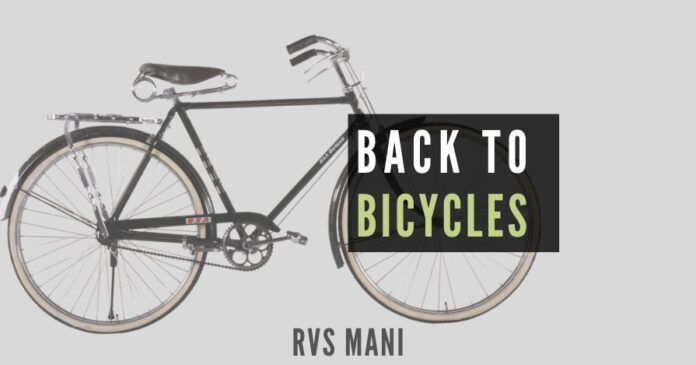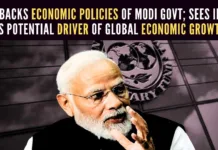
Meets the social distancing & sustainable commuting needs
As a student of 9th class in 1972, it was mandatory for us to read a magazine named “Science Today” which was a weekly magazine available in our school library. Besides being a laid down routine, the magazine also held out a few interesting features for us to interest us. I remember, to do it yourself in the electronics column by Mr. Borkar, and also some regular features covering subjects of interest to teenagers of the time like “Aerodynamics of a cricket ball” or special features on “bicycles” etc. Riding a bicycle was a matter of pride and owning one was something to flaunt among friends. Even the family bicycles also were out of bounds for greenhorns and we had learned to ride from the on hire bicycles which were available on hire at the neighborhood market in Sector 4, R.K. Puram, New Delhi. I still remember the name of the store as “Surinder Stove and Cycle store.” We would be able to ride the family bicycle-only after we became adept at riding the hired ones. But such small drops of happiness seems to have vanished from the growing years of today. It is not out of deprivation bur due to overindulgence that these small gifts are missing from the lives of growing teenagers today.
I also recall that in one of the editions of this Science Today, it was mentioned that people going to work in cities like Delhi, Pune, etc. predominantly used bicycles for commuting to work. We could even visualize while going to school the huge number of bicycles being ridden by different levels of office goers irrespective of hierarchy or status. Every office building had a cycle stand, in which specially designed iron rods had been molded and implanted to enable the fore wheel of the cycle to be placed and locked to ensure its safety. Not just in offices but also in colleges and even schools we had many students, teachers, and staff coming in bicycles. In fact, the proud possession would also come in handy for carrying the common cricket bag while going for inter-college matches, and also in bunking school or college for a movie in Chanakya cinema in Yashwant Place, New Delhi. The Chanakya cinema had a lovely cycle parking space so did most theatres in south Delhi at that time like Sangam or Kamal. Priya was an exception due to the fact that due to the enormous availability of space at that time (now Jayaprakash Hotel has come in there), the parking was overground. Even the bicycle was a handy means of transporting monthly grocery or disposing of unwanted utilities, old newspapers, etc. The motivation for this was the money realized in the sale of unwanted goods and old newspapers (Kabaadi) was your pocket money supplement.
In the present circumstance of the COVID-19 pandemic in India, the use of this for commuting by its own design enables many of the proscriptions stipulated in these lockdown times.
But now I don’t see the bicycle being used for such simple utilities. You have a below-par economy class of service providers using these bicycles who immediately upon getting the required financial strength graduate to motorized vehicles like a scooter or a motorcycle. We can see it all around us the usual masons, plumber, electrician, the vegetable and fruit vendor, the neighborhood pan, and cigarette vendors everywhere around us in India. In other parts of the world riding a bicycle to work is still in vogue. In the 1990s when this syndrome of missing bicycles in Delhi was beginning and tagging riding of bicycles to the office was also beginning, I saw in the University of Manchester, Mr. Lloyd Edomonds Assistant Professor, regularly riding to his work in bicycle, The fact that he owned a fancy car could be known only on the rare occasions he used to bring it to the institute. During this period the bicycle stands in most of the workspaces in Delhi was being replaced by Scooter stands. Not just in workspaces but also in other neighborhood markets, schools, and colleges, etc. In school, you could see a marked trend of parents dropping their children in schools in their personal vehicles.
But do we appreciate the virtues of this excellent instrument called the bicycle? It is not just a transport or commuting vehicle. Riding it gives a lot of other attendant benefits. In the present circumstance of the COVID-19 pandemic in India, the use of this for commuting by its own design enables many of the proscriptions stipulated in these lockdown times.
Enforced halt at home due to lockdown has caused me to read quite extensively. During this course of reading, I have noted certain important observation which was put in the context of the COVID-19 combating. Many prestigious organizations, prominently WHO, WRI, ECF and Forbes magazines and so on have brought out advisories for intensive usage of bicycles for achieving four prerequisites for dealing with COVID-19 crises:
- For maintaining social distancing
- Attaining higher immunity (physical and mental health)
- Sourcing essential goods and micro-mobility of essential service providers in the neighborhood
Further, I also came across that In fact, many countries including China (286000 people used bicycles for 2mn miles in Wuhan), USA (cycling increased by 150% in Philadelphia, by 67% in New York and made emergency bicycle lanes in Bogota of Columbia), Ireland (Dublin witnessed booming Bicycle business), India (Movement of workers for essential services/goods as also several thousand migrant workers using Bicycles for returning to their homes, even covering few hundred km as extreme cases) and so on.
I was given to understand that originally the public bike-sharing was introduced in certain areas of Bhopal but due to change of government, the same was vitiated beyond feasibility.
Another article I came across about the declining trend of bicycle use is captured as follows
In India, bicycle usage varied from below 10% of households to more than 70% of households. Mode share of cycling in the total mode shift had declined substantially over the decades and is currently reported to be between 7 and 21%. As a matter of fact, 750 million Indians can’t afford to buy a bicycle. A study for “Mode used to travel for work” mentions that approximately 200 million people travel by foot up to 10 km for their work[1]. At the macro level, if the business-as-usual scenario continues cycling (& walking) is estimated to plummet from 43% to 34% by 2030. At the global level, percentage bicycle ownership per capita of India is meager 9 as compared to 30 of China, 70 of Japan, and 110 of The Netherlands. It confirms the huge bicycle usage – gap within India and w.r.t best international indicators.
But we don’t really need to source this much data to really assess and appreciate the benefits of using bicycles. We had harnessed these benefits in earlier times. Further, the issues of pollution and energy efficiencies were not on the agenda when the bicycles were in vogue in the previous inning, but having tasted the vice of pollution and also with appreciable sensitization amongst populace on the need to optimize the finite energy resource which is draining the Foreign Exchange Reserves is also a benefit multiplier. In fact, one prominent activist of Delhi Sunita Narain is already leading by personal example by riding a bicycle to work. We also have a certain institution with its workspace in India Habitat Centre encouraging its employees to use bicycles had arranged for bicycles to be kept in two proximate metro stations to their workspace.
These are the sign of increased appreciation of the virtues of the popularising use of bicycles for commuting. In fact, I have seen it in Singapore, Melbourne, etc were riding a bicycle for commuting is very common. In fact, based on the Public Bicycle Sharing model in Singapore the same has been introduced in the NDMC areas in New Delhi. Within this limited area, it is working very successfully. But we need to implement in all cities and all corners of the cities seamlessly. Besides, there is a need to treat this as a public interest strategy and not a political tool. I was given to understand that originally the public bike-sharing was introduced in certain areas of Bhopal but due to change of government, the same was vitiated beyond feasibility.
There are many more such possibilities that could be explored. Like a 20% tuition fee incentive for all students of schools, universities, and colleges who undertake to commute their institution on a bicycle. Similar incentives could also be considered in public transport fares, transport allowances of employees in the organized sector wherever applicable, and other benefits through fiscal and non-fiscal measures where the benefit is handed directly in the hands of the bicycle user like DBT scheme. Take adequate safeguards against misuse. Abandon the patronage of cars to employees. Every incident of official car use even if it is for the highest placed should ensure a component of bicycle use. The operational modalities could be worked out one of these. The buggies in the airport to great extent used for transporting people from terminal entry to boarding gate should be partly replaced with bicycle ride so that fitter people could use them which would offer the benefit of social distancing also.
There are enormous benefits of bicycle especially in these times of pandemic. But given the disturbing trend of decreasing the use of bicycles even in traditional usage areas does not augur well. We are not just missing out on an opportunity to address the distortions but actually accentuating the distortions. We are increasing the avoidable energy dependency in the economy. The obsession with status linked with ownership and usage of motorized transport is in fact further reinforcing which would a major constraint to this bicycle movement required for this country. I do not want to make a value judgment on the practice per se, but even in Stree Dhan in marriages, the trend of giving motorcycles in place of hitherto humble bicycles had to get more and more popular even in the remotest area of the country, In fact, this should be reversed.
In 2014 Honorable Prime Minister Shri Narendra Modi Ji initiated a long-overdue Swach Bharat Abhiyaan for doing away with the practice of open defecation. This is had in fact stood us in good stead in combating the further spread of COVID-19.
I would also urge the Honorable Prime Minister to extol the citizens to use a bicycle as a mode of commuting for the spinoffs from this could be many. Using the same template of mass communication with its citizens, this message could also carry the message that if a man doesn’t use a bicycle for commuting and using motorized transport polluting the environment, his new bride should do similar as in the Swach Bharat Abhiyan message.
Note:
1. The views expressed here are those of the author and do not necessarily represent or reflect the views of PGurus.
References:
[1] MOBILITY IN RURAL INDIA – STILL A DISTANT DREAM?? – UITP India
- My musings on terror - November 23, 2022
- Tarun Tejpal case Judgment: Is it a symptom or a disease? - May 27, 2021
- Pillars of democracy should be partners in nation building - May 17, 2021











A thought provoking article. Government of the day should seriously consider implementing this.
–
A total ban of ‘Polluting Auto Vehicles’ should be implemented within City & Town limits.
–
This will force Car, Scooter & Motor Cycle users to go in for Cycling or Walking or Public Transport.
–
To be in perfect Health, a Human being should walk at least 10KM or ride 30KM bicycle.
–
If everybody follows this, 70% of the Polluting Vehicles can be taken off the roads.
–
Alarming Air Pollution which is pushing Man towards dangerous diseases can almost be prevented
—
Huge import bill on Hydrocarbons can be avoided. Economy will improve.
–
There may be job losses in the Automobile Sector. But the jobs created in Bicycle sector will more than compensate the job loss in the Auto Sector.
–
General Health improve. Heart Attacks, Diabetes, Stroke, High BP & even Cancer will become History. –
–
I am 63 working in a Gulf Country. Daily I bicycle 10 to 12 KM from/to Home/Office for the last 7 years. Even during scorching summer, I bike my way to Office/Home
The Govt. at best can do the following: encouraging cycling by removing taxes on bicycle sales. The resultant reduction in prices will increase the attraction for cycles. Also free accidental insurance cyclers and such other things can be explored. Next to increase taxes for registering all kinds of personal motor vehicles making the cost of their maintenance prohibitive. At the local Government level measures like placing restrictions on movement of personal vehicles on roads should be contemplated. Public transport only has to be encouraged in respect motorised movement. Next encouragement to bicycles only. But above all, the efforts at motivational and inspirational level only can bring the desired change.
My suggestions
1. Govt and other aided institutions must stop giving Motorcycle advance to their employees
2. The transport allowance now being given should be doubled to those who come on Cycles to the office
3. Police should provide Cycle lanes. In the west, it is very common,
4. The Head of the Dept should come at least once in a week on cycle.
5. Incentives must be given to students, employees, workmen who come to the office, School, Factory etc by Cycle
6. Above all Sri Narendra Modi, the P.M of India must support cycle using as a fitness regime. It should be done in the way Swatch Bharath Abhiyan is being done.